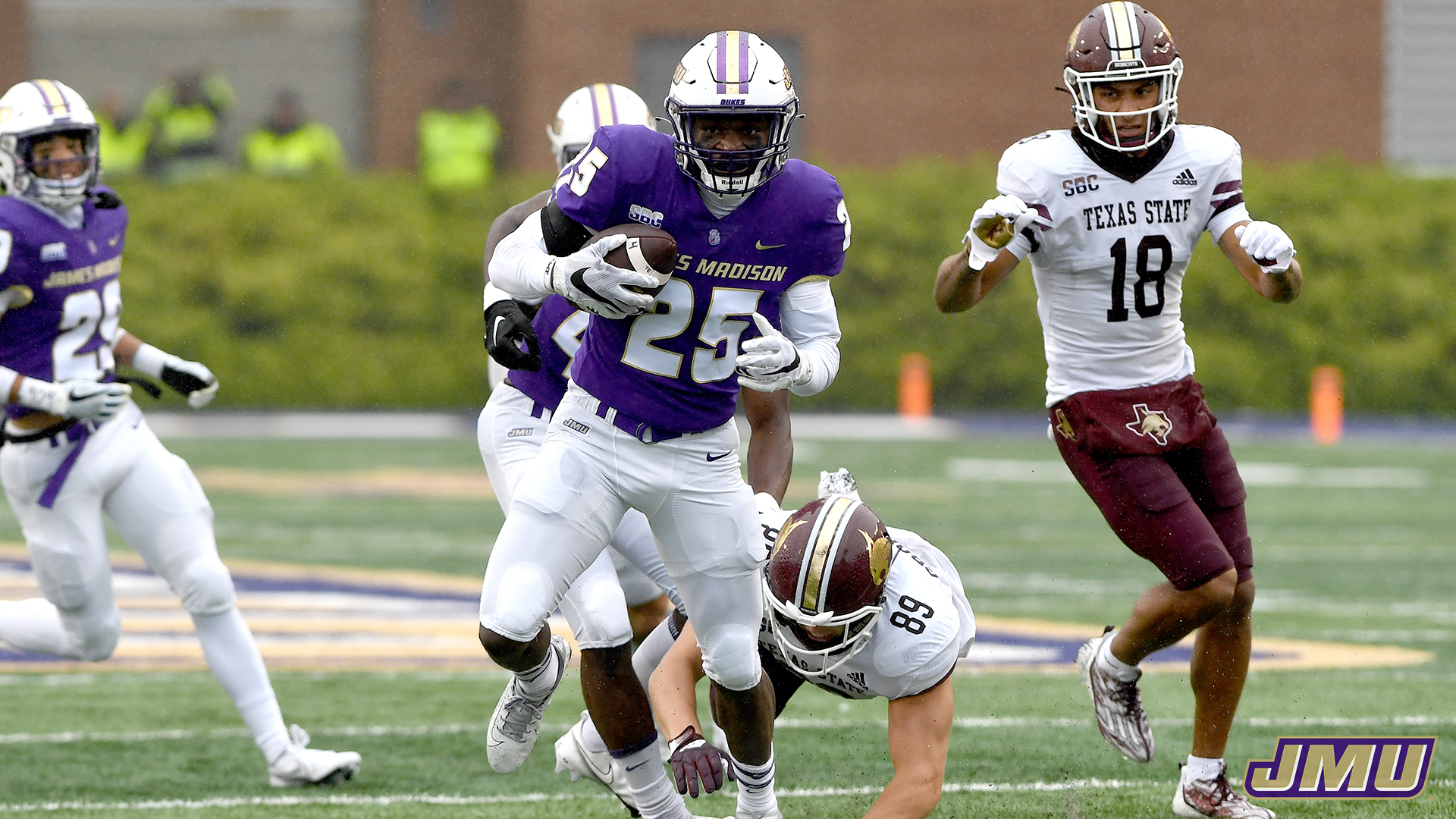Image courtesy of JMU Athletics Communications
By Bennett Conlin
Typing that headline made me chuckle, as I would not have expected to write that a few weeks ago. Alas, here we are.
BreakingT, which was founded by a JMU alumnus, is selling shirts with “Rank the Dukes” written on the front. Even ACTUAL AP POLL VOTERS are putting the Dukes in their top 25. Twenty two (!) voters ranked JMU this week.
The Dukes aren’t yet ranked, though. They’re technically 30th, receiving 39 “points” in the latest poll. For those wondering, a team earns points for every vote. A first-place vote is worth 25 points, a second-place vote is worth 24 points, a third-place vote is worth 23 points … you get the point. After everyone votes, the points are tallied, and the top 25 is released, with the teams earning the most points being ranked the highest. Makes sense!
So does JMU deserve to be ranked?
Strength of record roots
ESPN ranks the Dukes 16th in its strength of record metric. The website says strength of record “reflects the chance that an average top 25 team would have their record or better, given their schedule.”
JMU’s 4-0 record is solid! The win at App State is a big-time win, and beating Middle Tennessee holds more weight with the Blue Raiders beating Miami.
JMU has also looked really, really impressive in its wins. The Dukes have a +124 point differential through four games, winning a close one against App State and smoking Middle Tennessee, Norfolk State, and Texas State.
When you watch JMU play, the Dukes look the part of a top-25 team. That doesn’t mean that will continue all season, but watching them the last few weeks has been impressive. They’re very good, and they pass the “eye test” and strength of record test.
In fact, of teams in the top 25 of ESPN’s strength of record metric, only Coastal Carolina, Maryland, and JMU are not included in the latest AP top 25. The Dukes were snubbed!
Predictive metrics don’t love JMU
ESPN’s Football Power Index, a predictive metric, ranks the Dukes 63rd. Harsh? Probably, but it’s not an outlier. FEI, an efficiency metric with an eye toward predictions, has JMU 64th. The Sagarin Ratings have JMU 56th. ESPN’s SP+ has JMU at No. 34.
These data points still peg JMU as one of the top teams in the Sun Belt, but they don’t view the Dukes as a top-25 team.
Using predictive rating systems, it’s hard to justify JMU being ranked. If the Dukes were stacked up against other top-25 teams on a neutral field, they’d often be an underdog.
But I’m not sure the average AP voter looks at all those predictive ranking systems, even though they’d be better informed if they did.
Life as an AP voter
As a former AP poll voter myself (humble brag), I’d stick the Dukes in my top 25 given the team’s strength of record. Each voter has flexibility in how they vote, though, which makes this tricky.
Voters are certainly supposed to value head-to-head results, a team’s overall record, strength of schedule, etc. but we’re kidding ourselves if we pretend the AP poll is much more than a bunch of busy reporters haphazardly putting together a list of top teams to preserve tradition.
If you’re a beat reporter at a local newspaper like I was, you’re not watching film of every college football team to make sure your ranking is perfect. You don’t get paid to vote in the AP top 25, but you do it because of the poll’s tradition, and in my case, I thought it was fun!
There were times when I probably would’ve (and maybe should’ve) voted differently if I had watched more games that weekend or looked deeper into advanced analytics. I used analytics and recent results to guide my ranking decisions, but when you’re traveling to cover a team and writing 3+ articles in a weekend and preparing for the work week ahead, you don’t have the time to thoroughly analyze every team near the top 25.
Louisville trip, baby!
Let’s use an example to better illustrate the point. Say I’m flying from Charlottesville to cover UVA at Louisville.
The game kicks off Saturday at 3:30 p.m. ET. I’m inside the stadium to cover the game by 1:30. I’m looking to see if any UVA or Louisville starters aren’t suited up. I’m walking around the stadium to get a feel for the game-day atmosphere. How many UVA fans made the trip? Spoiler: it’s probably not that many.
As a result, I’m likely not watching more than the first half of any noon games on TV. At 3:30, my entire focus is on UVA-Louisville. After the game ends, I’m interviewing players and coaches and writing stories until 9-10 p.m. I’m missing the entire 3:30 window of games, and I’m not catching most of the night games, unless it’s a late-night Pac-12 game. Even then, I might opt for sleep over Washington-Oregon State.
My AP top 25 ballot was due by noon ET on Sunday, and I typically flew home early in the morning to secure the cheapest flight possible — ahh the beauty of working in local news! That means I’m waking up, going to the Louisville airport, and flying home. I might have a free hour or so during my morning to submit my ballot, and I may be finalizing it from an uncomfortable airport terminal with spotty WiFi.
Realistically, most AP poll voters don’t watch your team play on a regular basis. I didn’t.
Again, the poll exists largely because of tradition, but I’m not sold on its merits in 2022. Although, it does matter for other reasons.
What matters to voters?
Voters have to find criteria they consider most important to make voting a quick and efficient process during a busy fall.
Strength of record was a key metric for me when I voted. I wanted to value what a team had actually accomplished more than what it was projected to do, although I didn’t completely dismiss the predictive metrics.
Other voters focus more on strength of schedule, leading to more Power 5 teams in their poll. Some simply say, “I think this team is better based on my eye test.” Some might need to submit their ballot in 15 minutes, look at last week’s poll, and replace teams that lost with teams in the receiving votes section from the week prior. Yes, I guarantee over the years that sometimes the voting process is that lazy.
Some votes don’t make any sense.
When will JMU be ranked?
So why isn’t JMU ranked? Because the AP poll is an imperfect system, and I guarantee several voters haven’t watched the Dukes play a single snap this season. Gasp!
It also often takes media attention for a Group of 5 team to enter into the AP top 25, and JMU is just transitioning from the FCS. The Dukes were relatively unknown entering the season, and their current resume makes them a fringe candidate for the top 25. That’s not an ideal combination to earn a spot in the AP ranking.
It’s also worth noting that attention builds quickly. No AP poll voter wants to look like an idiot, especially since votes are tracked and angry fanbases will fill your email/Twitter mentions.
If the Dukes keep winning, they’ll be ranked soon.
By receiving votes this week, the Dukes are starting to gain enough attention from voters that another win or two will move them into the top 25. People are starting to notice JMU, which is arguably the best way to enter the poll. Why do you think programs like USC, Michigan, and Texas always start the season inside the top 25 even if the team isn’t expected to be great? Branding matters.
The Dukes are in prime position to break into the top 25 in the coming weeks, as national attention continues to head their way.
Patience JMU fans. You just need a few busy voters to see a bunch of tweets about the Dukes moving to 5-0 with a win over Arkansas State, and bam! The Dukes have a little number next to their name on Saturdays.


Leave a Reply